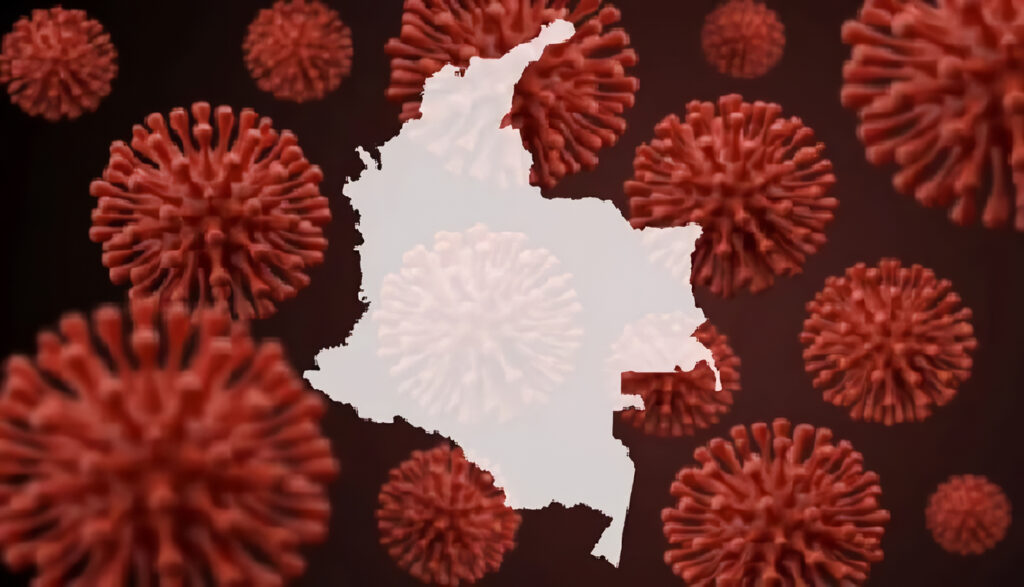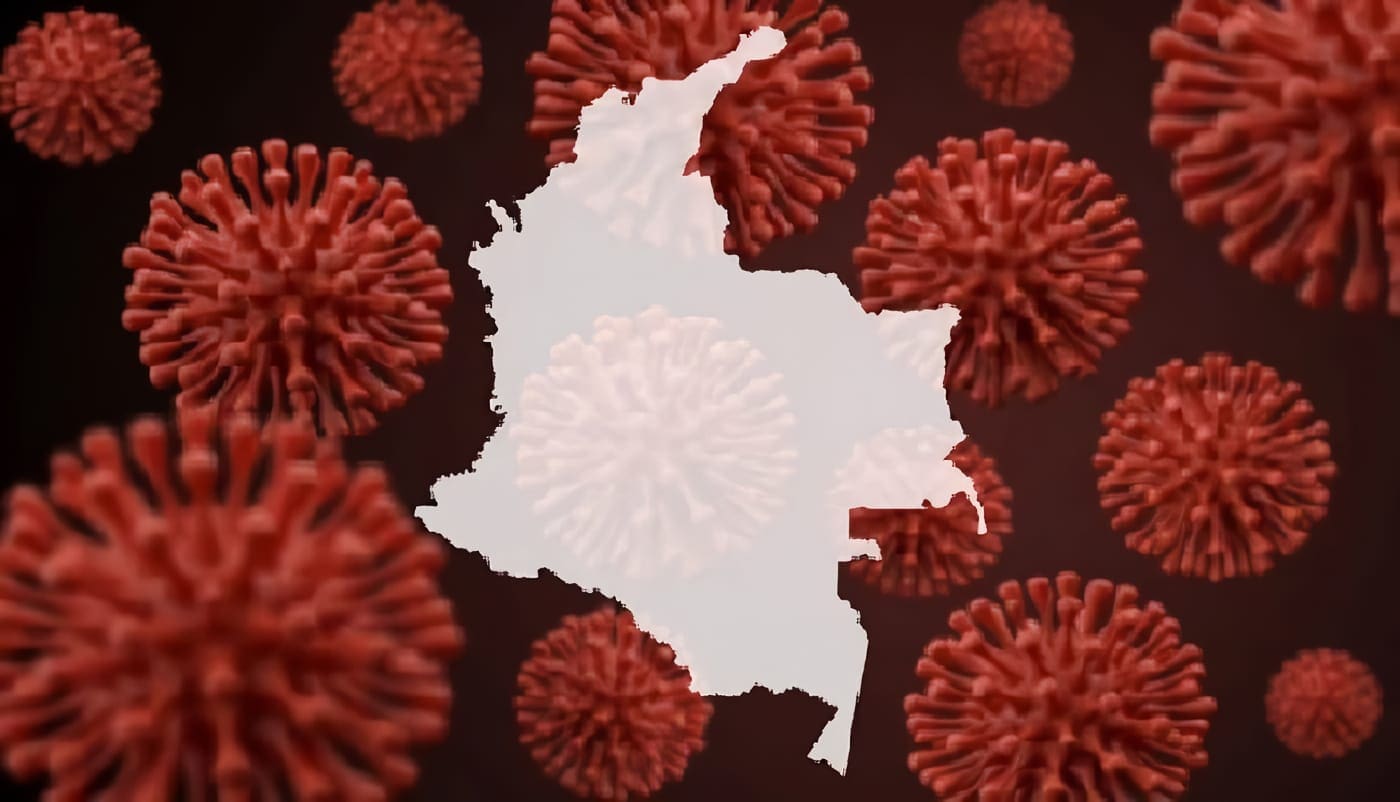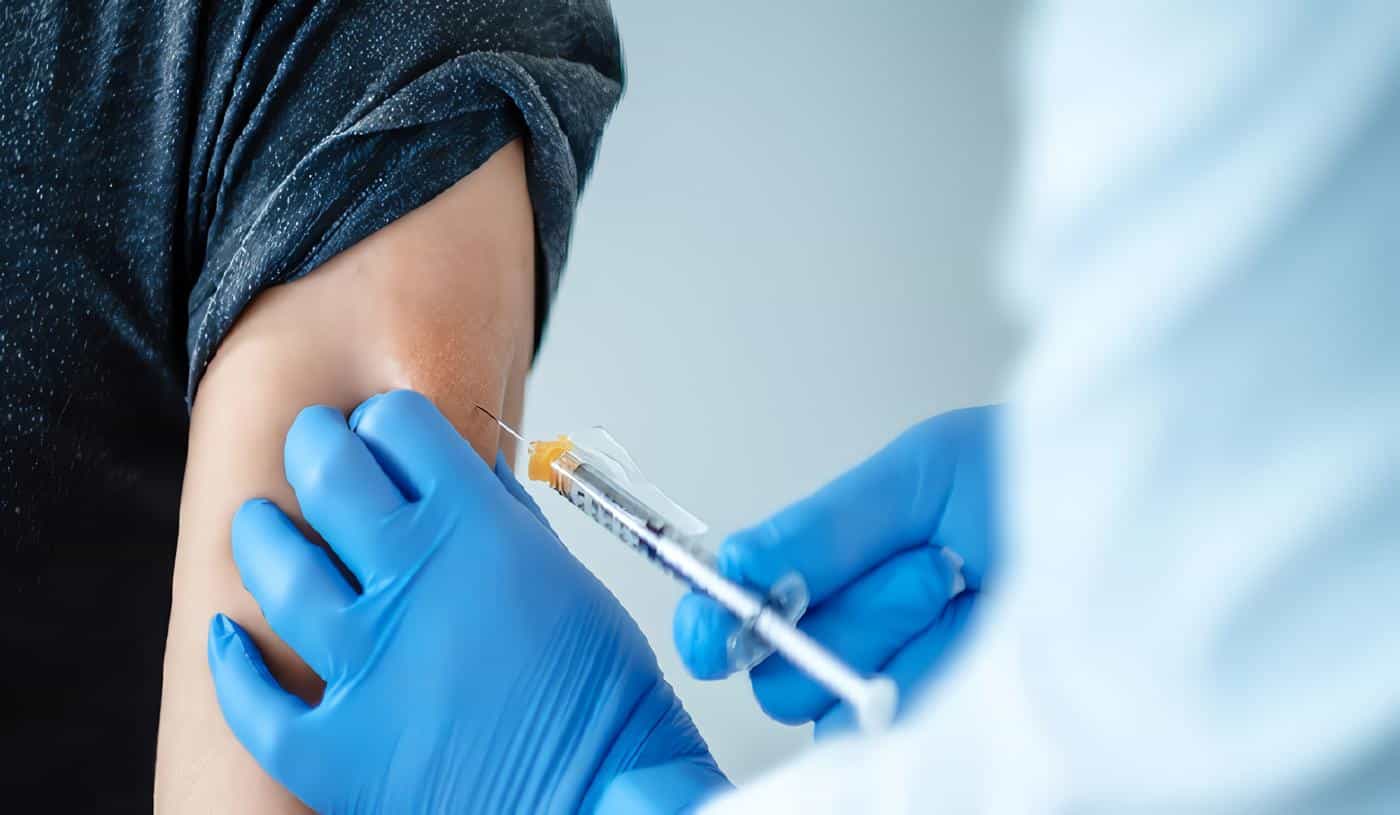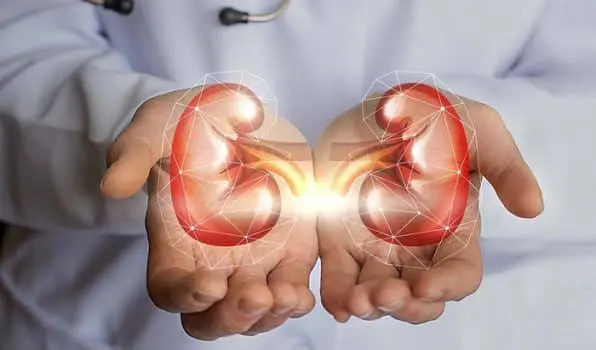Abstract
The control of SARS-CoV-2 infection is one of the main challenges for health authorities worldwide, and one of the strategies for its control would be to delve into the geospatial dynamics of this infection.
The objective of this research was Describe the geospatial and epidemiological dynamics of SARSCoV-2 infection in the department of Córdoba. Between March 2020 and July 2021, a prospective descriptive study was carried out on the Spatio-temporal dynamics of the infection by SARS-CoV-2 in the department of Córdoba, area of the Colombian Caribbean.
The information in the data of cases confirmed by SARS-CoV-2 of the National Institute of Health (INS) of Colombia and the sociodemographic database of the national statistics department was used. Our data show that SARS-CoV-2 spread throughout the department of Córdoba. The highly populated clusters of the region were the most affected.
The age variable mainly explains the mortality rate in the department (p <0.05, OR 18). Finally, Control the infection, and it is essential to monitor and predict the geographic areas with the highest risk of SARS-CoV-2 infection to implement public health strategies to reduce morbidity and mortality.
Palabras clave: Surveillance; Public Health; COVID-19; Epidemiology; General Social Development; Population.
Monitoreo Espacial y Epidemiológico de la Infección por Sars-Cov-2 en una Región del Trópico Colombiano
Resumen
El control de la infección por SARS-CoV-2 es uno de los principales desafíos para las autoridades sanitarias a nivel mundial, y una de las estrategias para su control sería profundizar en la dinámica geoespacial de esta infección.
El objetivo de esta investigación fue describir la dinámica geoespacial y epidemiológica de la infección por SARS-CoV-2 en el departamento de Córdoba.
Entre marzo de 2020 y julio de 2021 se realizó un estudio descriptivo prospectivo sobre la dinámica espacio-temporal de la infección por SARS-CoV-2 en el departamento de Córdoba, zona del Caribe colombiano. Se utilizó la información de los datos de casos confirmados por SARS-CoV-2 del Instituto Nacional de Salud (INS) de Colombia y la base de datos sociodemográfica del departamento nacional de estadística.
Nuestros datos muestran que el SARS-CoV-2 se extendió por todo el departamento de Córdoba. Los conglomerados densamente poblados de la región fueron los más afectados. La variable edad explica principalmente la tasa de mortalidad en el departamento (p<0.05, OR 18).
Finalmente, para controlar la infeccion es fundamental monitorear y predecir las áreas geográficas con mayor riesgo de infección por SARS-CoV-2, e implementar estrategias de salud pública para reducir la morbilidad y la mortalidad.
Palabras clave: Vigilancia; salud pública; COVID-19; epidemiología; desarrollo social general; población.
Highlights
- The variables sex, age, and UBN explain the fatality in this region.
- In 2021 the highest peak of cases is likely related to the entry of variants of interest such as Mµ, Gamma, and Iota.
- The public health efforts should focus on vaccination in hot spots and vulnerable populations to limit the expansion and reduce the damage caused by SARS-CoV-2.
Introduction – Spatial and Epidemiological Monitoring of Sars-Cov-2 Infection in a Region of the Colombian Tropics
The control of the SARS-CoV2 infection has been the main problem of the scientific and health community in the last year since this new infection has become the main challenge in public health for health systems around the world. SARS-CoV-2 has caused more than 420 million reported infections and the death of more than 5.8 million people worldwide (1).
One of the strategies for controlling SARS-CoV-2 is to know the geospatial dynamics of the infection, which would allow us to understand the failures when facing the waves of SARS-CoV2.
On the other hand, in 2020, our research group studied the dynamics of this infection in the department of Córdoba, evaluating through serological tests the presence of total antibodies against the SARS-CoV-2 nucleocapsid protein in the most representative municipalities. from this department showing high seropositivity (41%) in this region (2).
However, serology does not show real-time viral mobility and spatial distribution of human clusters infected with SARS-CoV-2. Currently, the location of the affected populations is crucial to understand the geographic areas most susceptible to new waves of infection.
Therefore, the analysis of geolocation data, clinical and sociodemographic information of the cases confirmed by SARSCoV-2 of the department are crucial to understanding the dynamics of the infection. Therefore, the objective of this work was to describe the geospatial and epidemiological dynamics of SARS-CoV2 infection in the department of Córdoba, Colombia.
Methodology – Spatial and Epidemiological Monitoring of Sars-Cov-2 Infection in a Region of the Colombian Tropics
Between March 2020 and July 2021, a prospective descriptive study was carried out on the Spatiotemporal dynamics of SARS-CoV-2 infection in the department of Córdoba, the department is located in the North-West of Colombia in an area of the Colombian Caribbean.
The information consigned in the database of cases confirmed by SARS-CoV-2 and their severity of the National Institute of Health (INS) of Colombia (1)( and the sociodemographic database of the National Administrative Department of Statistics (DANE) were used (2).
The severity of the disease criteria used by INS and the Colombian Association of Infectious Diseases (ACIN) (3,4) were followed:
a) Mild disease: local symptoms in the upper respiratory tract and may present with nonspecific symptoms such as fever, muscle pain, or general malaise.
b) Moderate disease: clinical or radiological evidence of lower respiratory infection, with compatible lung images and O2 saturation> 93%.
c) Severe disease: respiratory rate greater than 30 / min, oxygen saturation <93%, PAFI (the relationship between arterial oxygen pressure and the inspired fraction of oxygen (PaO2 / FiO2) less than 300, infiltrates more than 50%.
The integration of the two databases made it possible to relate (cases / 100,000 inhabitants) and compare the casuistry between the different municipalities.
Additionally, it was possible to integrate the index of unsatisfied basic needs (UBN) (5), an official indicator representing each municipality’s main socio-economic aspects in Colombia.
Risk factors associated with mortality and trends in the geographic distribution of the cases were analyzed.
Through a logistic regression model, mortality from COVID-19 was analyzed with the variables sex, age, and UBN. The continuous variables (age and UBN) were transformed into category variables, which were established as high and low, the respective means were used as a cut-off point.
An epidemic curve was constructed with confirmed cases and the number of deaths in the department of Córdoba and its capital Montería. Data were aggregated as epidemiological weeks during the study period.
Additionally, the leading social events that could affect the behavior of the pandemic were analyzed, such as Easter, days without VAT, end-of-year holidays, and the first four stages of the vaccination plan.
Finally, two epidemiological maps were constructed with the distribution of the infection during the pandemic. The kernel density estimator (6) was used on the cases of each municipality, and it was related to the population (cases / 100000 inhabitants/municipalities). A bandwidth of 40 km was used, and the QGIS program, version 3.4.
Results – Spatial and Epidemiological Monitoring of Sars-Cov-2 Infection in a Region of the Colombian Tropics
Until July 23, 2021, in the department of Córdoba, 97,534 cases of COVID-19 were reported, of which 53,130 (54.5%) were in women, and 44,404 (45.5%) were men. The mean age was 41.3 years (95% CI, 41.1 to 41.4). Two thousand eighty-three men died, which produced a high fatality of 4.7%. In contrast, the fatality in women was lower, with 1.375 (2.6%) deaths. The average NBI was 26.9% (95% CI, 26.9 to 27.0), and the average of each case in the department was 1.18 cases / 100,000 inhabitants (95% CI, 1.17 to 1.19).
When analyzing the cases in each municipality, it was observed that Montería, the department’s capital, was the city with most cases 51,803 (53.11%). The other municipalities with the most cases of SARS-CoV-2 in their order were: Cerete, Sahagún, Chinú, Cotorra, Pueblo Nuevo, Ciénaga de Oro, Lorica, Canalete, Montelíbano, Momil, San Pelayo and Planeta Rica (Table 1).
Table 1. Sociodemographic characteristics of SARS-CoV-2 infection in the Cordoba.
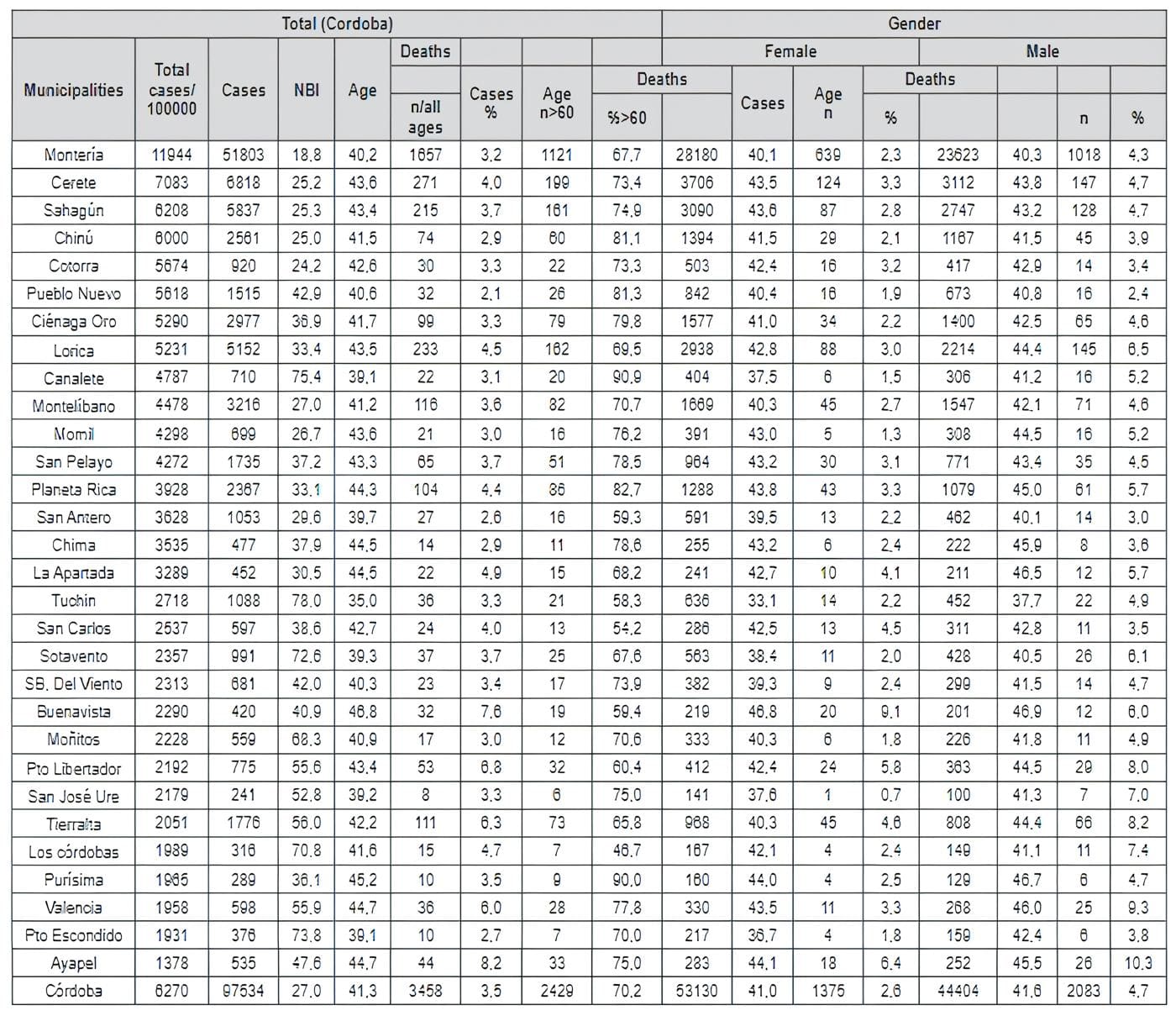
When comparing the average ages with the different forms of the severity of COVID-19 reported by the INS, a statistically significant difference was observed (p <0.0001), the group of individuals who died had an average of 67.7 years. In contrast, the mild forms of the disease had an average age of 40.1 years.
Furthermore, no differences were observed in the mean age between individuals with severe (48.3 years) and moderate (48.6 years) forms of this disease (p> 0.05). (Table 2).
Table 2. Relationship between age and gender with the outcome of SARS-CoV-2 infection.
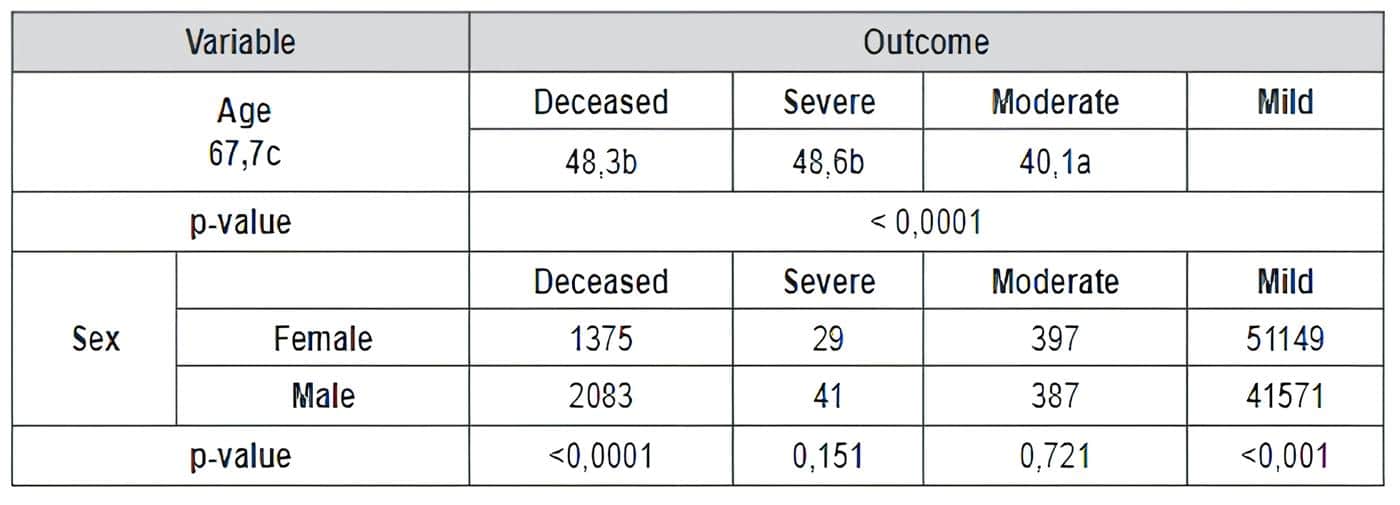
On the other hand, when evaluating the gender variable, a higher infection was observed in women (n = 53,130) than in men (n = 44,404). However, in men, the fatality rate was significantly higher than in women (p <0.0001) (Tables 1 and 2).
Variable’s sex, age, and UBN vs. the risk of death to explain the fatality in the department of Córdoba were analyzed. It was observed in the univariate and bivariate analysis that age was strongly associated with mortality in the department. These data allow us to infer that the department’s risk of dying increases 18 times (Tables 3, 4).
Table 3. Univariate analysis of variables associated with mortality from COVID-19 in Cordoba, Colombia.

Table 4. Multivariate logistic regression model for mortality from COVID-19 in Cordoba, Colombia.

The epidemic curve for the department of Córdoba and the municipality of Montería shows the confirmed cases of SARS-CoV-2 and the number of deaths observed and expected during the pandemic peaks of the years 2020-2021 (Figure 1). Regarding the confirmed cases of SARS-CoV-2, the first wave of cases in this department began in week 25.
The maximum peak was reached in week 31 of 2020. The week coincided with the commercial opening of the day without VAT. Subsequently, a decrease in cases was observed between weeks 36 and 50 of 2020.
In week 51, there was a new commercial opening that coincided with the end of the year festivities, and from this week, a new increase in the number began of COVID-19 cases, which remained constant during the first quarter of 2021. In week 6 of the quarter, the vaccination plan against SARS-CoV-2 began.
From week 12 (Holy Week), exponential growth in the number of cases was observed until the maximum peak of reported cases of SARSCoV-2 in week 25. Later a significant decrease in cases was observed between weeks 26 -28 (Figure 1).
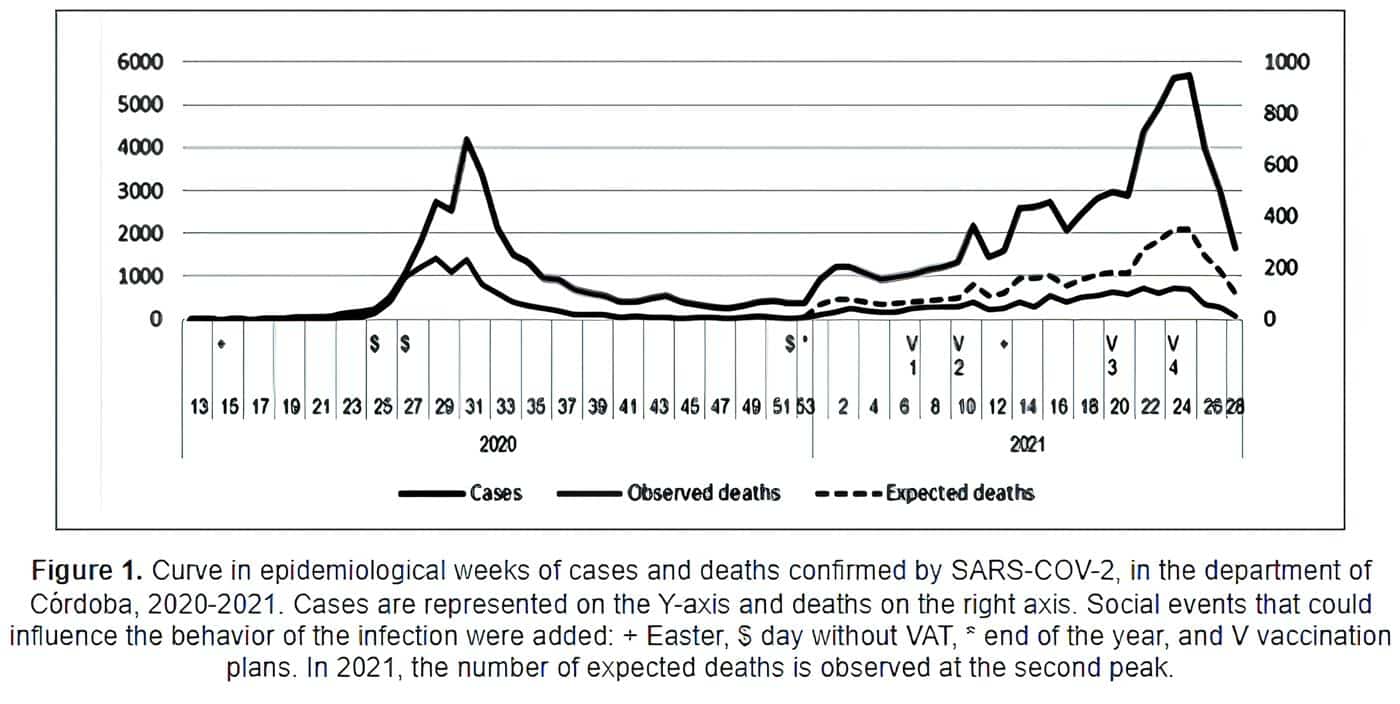
Figure 1. Curve in epidemiological weeks of cases and deaths confirmed by SARS-COV-2, in the department of Córdoba, 2020-2021. Cases are represented on the Y-axis and deaths on the right axis. Social events that could influence the behavior of the infection were added: + Easter, $ day without VAT, * end of the year, and V vaccination plans. In 2021, the number of expected deaths is observed at the second peak.
Regarding fatality in the department, a lower rate was observed in the peak of 2021 compared to 2020. When comparing the expected fatality rate in the second epidemic peak in 2021 compared to that observed in 2021, differences were observed between the expected lethality (n = 4,130) and observed (n = 1,741) (Figure 1).
Regarding the geospatial distribution of the SARSCoV-2 infection, the cases were concentrated in Montería and nearby municipalities such as Cereté (Figure 2). It was observed that the infection spread from Montería to the north of the department, affecting many municipalities (Cereté, San Carlos, San Pelayo, Cotorra, Lorica, Chima, Purísima, Momil, San Antero, Sahagún and Chinú).
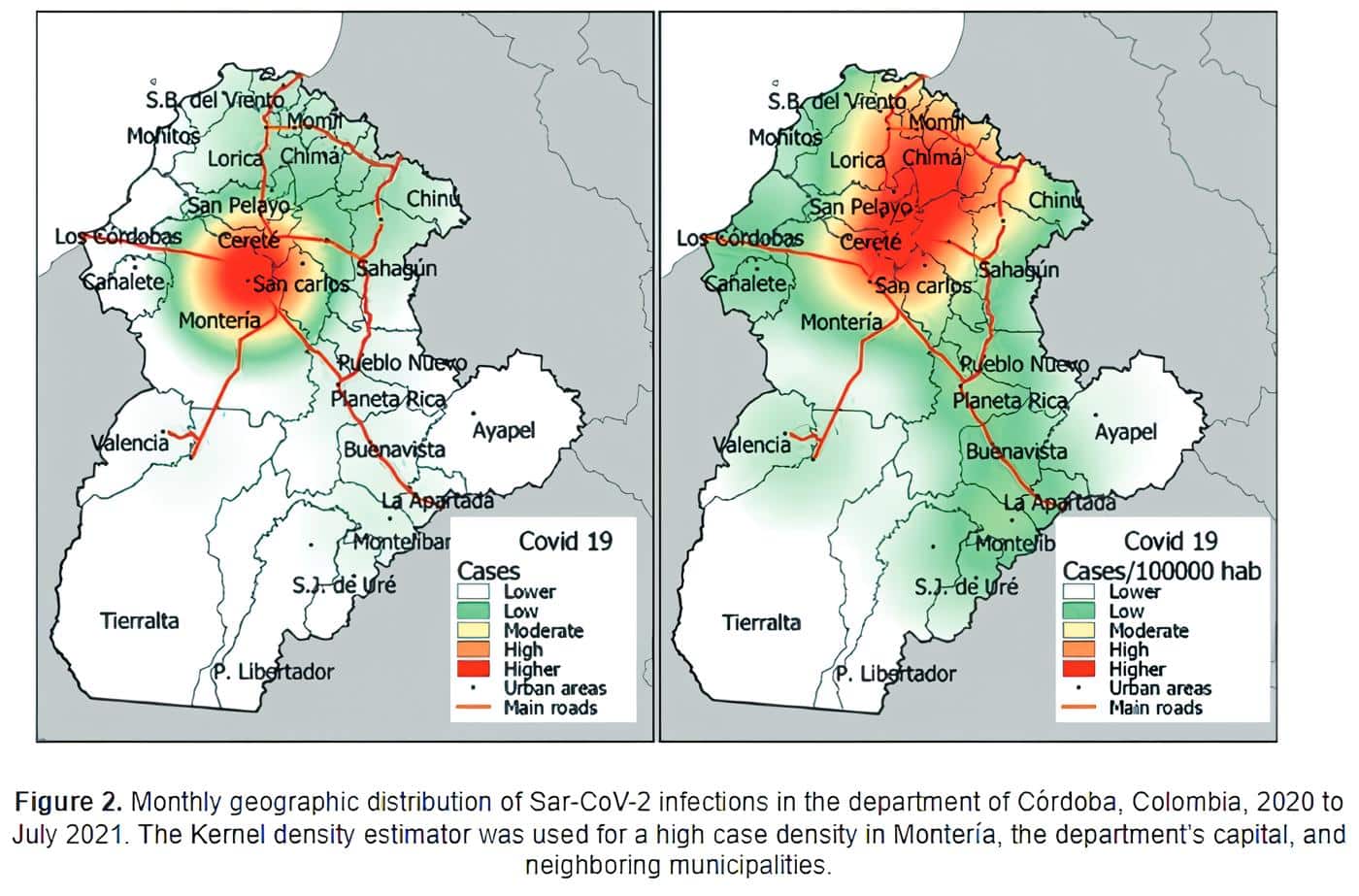
Figure 2. Monthly geographic distribution of Sar-CoV-2 infections in the department of Córdoba, Colombia, 2020 to July 2021. The Kernel density estimator was used for a high case density in Montería, the department’s capital, and neighboring municipalities.
Discussion – Spatial and Epidemiological Monitoring of Sars-Cov-2 Infection in a Region of the Colombian Tropics
Our data show that SARS-CoV-2 spread uncontrollably throughout the department of Córdoba, a situation that could be influenced by the predominant informal economy in the region studied (7) and for cultural reasons.
For this reason, a high rate of infection by this new coronavirus was observed in both men and women.
However, in men, the clinical evolution was worse than in women, which could be explained at the level of their lung cell membranes where there is a greater expression of serine proteases (TMPRSS2), which promote the cleavage of the Spike (S) protein (8)inflammatory cytokines, disease severity, and poor clinical outcomes among male patients with COVID-19.
The gradual decline in total and free testosterone levels has a direct correlation with serious pulmonary complications requiring advanced care (ICU, ventilators, ECMO, etc..
This mechanism would induce a higher viremia in men, which would trigger an exacerbation of their innate and adaptive immune response, thus generating inflammation, tissue damage, and a worse clinical evolution in men.
Regarding the region’s mortality rate, our analyses indicate that age behaves as a risk factor for mortality in the department of Córdoba. This would be related to the loss of innate and adaptive immune function due to aging (immune-senescence), which compromises its protection against infectious agents such as this new coronavirus (9).
Concerning fatality in older adults in the department of Córdoba, previous studies have shown that older adults have a higher risk of complications and fatal outcomes due to this infection (10,11).
Regarding the epidemic curve of the department of Córdoba (Figure 1), it was observed that the SARSCoV-2 transmissibility peaks in the year 2020-2021 were associated with activities that reduced self-care measures and promoted the agglomeration of people, such as the day without VAT, Easter and Christmas holidays.
In 2021 the highest peak of cases is likely related to the entry of variants of interest such as Mµ, Gamma, and Iota. These variants were related with the increased of the transmission of the virus in the department (12).
However, it is essential to note that despite having evidenced greater transmissibility of this virus in the Cordoba population, the mortality rate did not increase and was lower than that observed in 2020. This could be a consequence of two factors, the first being high seropositivity (41%) product of the natural infection against SARS-CoV-2 in the department of Córdoba and its capital Montería (55%) (5).
The second factor would be the vaccination of this population against this new coronavirus, currently the rate of fully vaccination at Córdoba population is around 31% (13,14). Therefore, the massive vaccination strategy must be accelerated to avoid the viral circulation and rapid transmission of concern variants of SARS-CoV-2 such as Omicron and its sublineages (BA.1, BA.2).
On the other hand, the higher density of COVID-19 cases in Montería and its nearby urban municipalities would be a consequence of the significant population and commercial mobility towards the capital of the department (Figure 2).
This makes it challenging to implement protective measures such as social distancing, which facilitates the circulation of SARS-CoV-2. Our results are similar to those of Yin et al.(15), who demonstrated that the new coronavirus’s advancement and speed of dissemination are related to urban areas with higher population density.
In conclusion, it is crucial to control SARS-CoV-2 infection to continue describing and predicting the geographic areas with the highest risk of infection and thus implement public health strategies to reduce the morbidity and mortality caused by this infection. Based on the results obtained, it is critical to suggest that public health efforts focus on buster vaccination in hot spots and vulnerable populations to limit the expansion and reduce the damage caused by the new coronavirus.
Acknowledgments – Spatial and Epidemiological Monitoring of Sars-Cov-2 Infection in a Region of the Colombian Tropics
To Ministerio de Ciencia Tecnología e Innovación, Colombia (MINCIENCIAS), AGROSAVIA.
References – Spatial and Epidemiological Monitoring of Sars-Cov-2 Infection in a Region of the Colombian Tropics
1.Instituto Nacional de Salud. Casos positivos de COVID-19 en Colombia.Bogotá: INS; 2021.
2. Departamento Administrativo Nacional de Estadística. Censo Nacional de Población y Vivienda – CNPV 2018 [Internet]. 2018.[consultado 2 febrero 2022]. Disponible en: www.dane.gov.co › censo2018 › CNPV-2018-VIHOPE-v2
3. Saavedra Trujillo C. Consenso colombiano de atención, diagnóstico y manejo de la infección por SARS-COV-2/ COVID-19 en establecimientos de atención de la salud Recomendaciones basadas en consenso de expertos e informadas en la evidencia [Internet]. 2020.[consultado 2 febrero 2022]. Disponible en: http://www.revistainfectio.org/index.php/infectio/article/view/851/896
4. World Health Organization. Clinical management of COVID-19 [Internet]. 2020.[consultado 2 febrero 2022]. Disponible en:https://www.who.int/publications/i/item/clinical-management-of-covid-19
5. Departamento Administrativo Nacional de Estadística. Necesidades básicas insatisfechas (NBI) [Internet]. 2021. [consultado 2 febrero 2022]. Disponible en:
https://www.dane.gov.co/index.php/estadisticas-por-tema/pobreza-y-condiciones-de-vida/necesidades-basicas-insatisfechas-nbi
6. Kloog I, Hain B, Portnov B. Using kernel density function as an urban analysis tool: Investigating the association between nightlight exposure and the incidence of breast cancer in Haifa, Israel.Computers, Environment and Urban Systems. 2009;33(1):55–63.
7. Departamento Administrativo Nacional de Estadística. Medición de empleo informal y seguridad social [Internet]. 2021.[consultado 2 febrero 2022]. Disponible en:
https://www.dane.gov.co/files/investigaciones/boletines/ech/ech_informalidad/bol-geih-informalidad-abr21-jun21.pdf
8. Hussain AN, Hussain F, Hashmi SK. Role of testosterone in COVID-19 patients – A double-edged sword? Med Hypotheses. 2020;144:110287.
Biblioographies – Spatial and Epidemiological Monitoring of Sars-Cov-2 Infection in a Region of the Colombian Tropics
9. Jergović M, Coplen CP, Uhrlaub JL, Nikolich-Žugich J. Immune response to COVID-19 in older adults. J Heart Lung Transplant. 2021 ;40(10):1082-1089.
10. Yanez ND, Weiss NS, Romand J-A, Treggiari MM. COVID-19 mortality risk for older men and women. BMC Public Health. 2020;20(1):1742.
11. García-Posada M, Aruachan-Vesga S, Mestra D, Humánez K, Serrano-Coll H, Cabrales H, et al. Clinical outcomes of patients hospitalized for COVID-19 and evidence-based on the pharmacological management reduce mortality in a region of the Colombian Caribbean. J Infect Public Health. 2021;14(6):696–701.
12. Instituto Nacional de Salud. Distribución geográfica de los linajes de SARS-CoV-2 circulantes en Colombia [Internet]. 2021.[consultado 2 febrero 2022]. Disponible en:
https://www.ins.gov.co/Noticias/Paginas/coronavirus-genoma.aspx
13. Our World in Data. Coronavirus (COVID-19) Vaccinations [Internet]. 2022.[consultado 2 febrero 2022]. Disponible en: https://ourworldindata.org/covid-vaccinations
14. Ministerio de Salud Colombia. Plan Nacional de Vacunación contra COVID-19 [Internet]. 2021. [consultado 2 febrero 2022]. Disponible en:
https://app.powerbi.com/view?r=eyJrIjoiNThmZTJmZWYtOW-FhMy00OGE1LWFiNDAtMTJm-YjM0NDA5NGY2IiwidCI6ImJmY-jdlMTNhLTdmYjctNDAxNi04-MzBjLWQzNzE2ZThkZDhiOCJ9
15. Yin H, Sun T, Yao L, Jiao Y, Ma L, Lin L, et al. Association between population density and infection rate suggests the importance of social distancing and travel restriction in reducing the COVID-19 pandemic. Environ Sci Pollut Res Int. 2021;28(30):40424.
Authrs – Spatial and Epidemiological Monitoring of Sars-Cov-2 Infection in a Region of the Colombian Tropics
1 Misael Oviedo, MD, Master en investigación social en salud, PhD en Bioética, ética aplicada y salud colectiva. Consultora del Fondo de Población de Naciones Unidas. Profesora de derecho a la salud, Universidad de los Andes.
2 Héctor Serrano-Coll, Instituto Colombiano de Medicina Tropical-Universidad CES, Medellín, Colombia.
3 Salim Mattar, Universidad de Córdoba, Instituto de Investigaciones Biológicas del Trópico, Montería, Colombia.
Recibido: 23 de marzo de 2022
Aceptado: 25 de marzo de 2022
Correspondencia:
Salim Mattar
smattar@correo.unicordoba.edu.co

